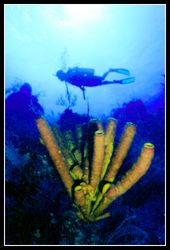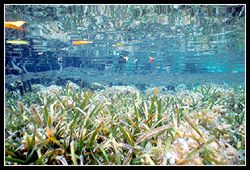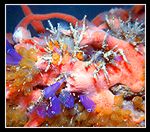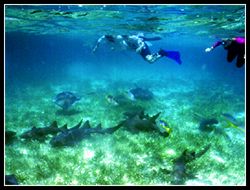
The Hol Chan Marine Reserve and Shark Ray Alley are the most popular diving/snorkeling sites in all of Belize. This is due to the close proximity of San Pedro, the large amount of fish life found with the Hol Chan "cut" accessible by snorkelers and beginning divers, the diversity of marine life encountered throughout the 4 zones of the park and the exitement and novelty of swimming with large numbers of nurse sharks and sting rays.
HOL CHAN CUT - Zone A
The Hol Chan Cut is only 15 minutes (4 miles) south of San Pedro and about 30 minutes north of Caye Caulker. Trips from San Pedro last about half day, while trips from Caye Caulker last a full day including a visit to San Pedro. During the boat ride to the park, keep an eye out for jumping rays and flying fish.

Due to the protected status of the area, the fish populations have exploded. In waters as shallow as 5 feet, large schools of jacks, groupers, snappers and barracuda abound. Along each side of the cut grow healthy stands of corals and seagrass in shallow water, perfect for the beginner snorkeler. The more experienced swimmer can swim from one side of the cut to the other, experiencing shallow reef, drop offs over the steep sides of the "cut", and seagrass and sand beds in the middle of the channel.
Outside the barrier reef, the ocean bottom gently slopes off into the Caribbean. All levels of diving can be accommodated here due to the variations in depth, from 30 to over 100 foot dives can be planned and executed. Spur and groove formations (hills of coral running parallel to valleys of sand) provide rich habitat for marine life. Spotted eagle rays and other pelagic creatures swim above the reef while the more cryptic life like lobsters and eels fill the holes and tunnels through the coral spurs.

It is necessary to use common sense and check with local knowledge prior to diving the Hol Chan Channel. During times of maximum tidal flow, the currents can be too strong to swim against. Whenever snorkeling in Belize, and especially at Hol Chan, it is essential that you have a good pair of fins and mask.
SEAGRASS BEDS - Zone B
While much less visited, the seagrass beds and mangrove roots of Zones B and C are well worth the visit if only for the novelty of what you might see. Seagrass beds are huge feeding grounds, and chances are that you will come upon huge sting rays feeding on the bottom, and schools of parrot fish and hogfish grazing on epiphytes growing on the seagrass. Though a very rare occurance, it is even possible to view manatee feeding in the grass beds.
The best method for exploring the seagrass beds is to have your boat drop you off about 200 yards from the mangrove edges, or near some other feature that your guide knows about, and to slowly swim toward the mangrove or feature. Swim slow and swing your head from side to side. Much of the life in the grassbeds is well camoflauged and cryptic, so you will have to key in on movement - a conchshell dropping as the snail reacts to your movement, a lizardfish darting to the surface to feed and then back down motionless, a sailfin blenny flagging. It is even worth your while to stop for a few minutes motionless and let the surroundings come alive.
MANGROVES - Zone C

Within the seagrass zone lies the Boca Ciega ("Blind Mouth") cave. This "blue hole" is a miniature version of the famed Blue Hole at Lighthouse Reef. You must be a cave-certified SCUBA diver to enter Boca Ciega, and only attemp to explore it after contacting the Reserve Manager at the office in San Pedro and securing an experienced cave-certified guide. The cave is considered dangerous,even by some experienced cave divers, and visibility in the area is generally poor.
Finally, while in the seagrass and mangrove zones, keep a keen eye and ear out for passing boats. Since most snorkeling and diving activity take place at the Hol Chan Channel, many boats speed through the other parts of the park. You can hear the wine of an outboard motor from a long ways away.

The mangrove habitat, especially the mangrove root systems that extend into the tidal range of the area, are one of the most colorful and biologically diverse habitats for marine invertebrates. Becareful while swimming among the mangroves. Stay well back from the silt laden roots, or you will stir up debris clouding the water. Gently float in toward a colorful root and be amazed at the layer upon layer of life struggling for space on the roots.
SHARK RAY ALLEY - Zone D
This recently discovered dive site has been selected as one of the
seven best "animal dives" in the Caribbean SKIN DIVER MAGAZINE. For years, local fishermen cleaned their catch just inside the reef, to the south of Hol Chan Cut and Ambergris Caye. The fishermen soon noticed that the offal from cleaning fish was attracting Nurse Sharks and several Southern Sting Rays. When the dive operators of San Pdero found out, they quickly investigated. What they found was a bonanza, and "Shark-Ray Alley" quickly became a very popular dive site.

The sharks and rays hear the dive boats approaching and begin to school in anticipation of bait being thrown into the water. When you arrive, you will see the surface often boiling with rolling sharks and sting ray wings as they vie for the scraps.
These creatures have a great tolerance for divers and snorkelers. The rays, which have a 'wing-span' of two to four feet, swim directly towards the divers, mouths often turned up hoping for a hand held tid bit to be placed near their mouths. Other have learned to swim in circles around the divers, as if performing for food. The docile Nurse Sharks average four to six feet in length and can be a bit more agressive than the sting rays.
It is important that you maintain your perspective. These are wild creatures first and as such, can be unpredictable in their behavior. The best course of action is to leave the touching and feeding to the dive masters, while you enjoy the show from a safe distance determined by your swimming skill and comfort level.